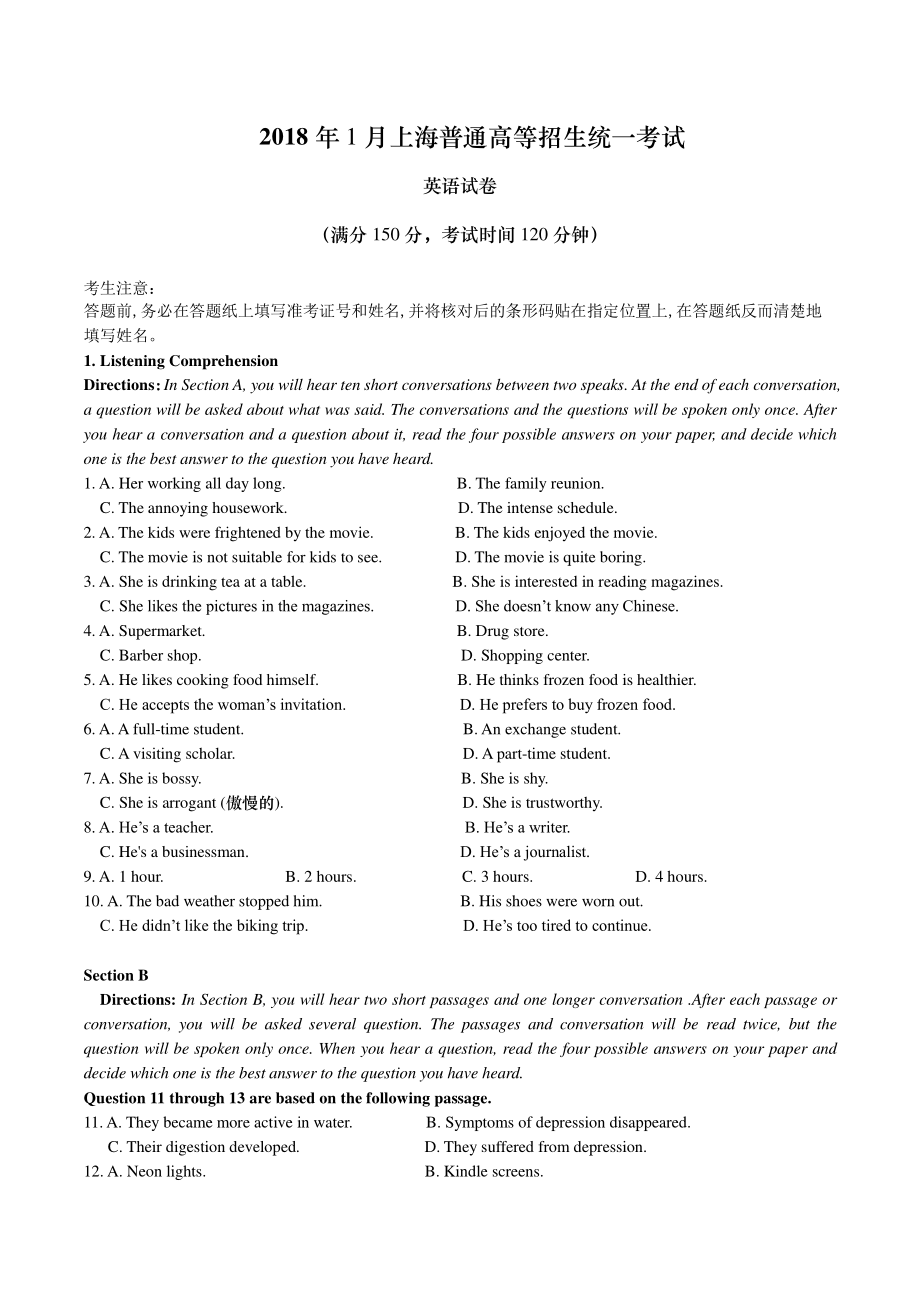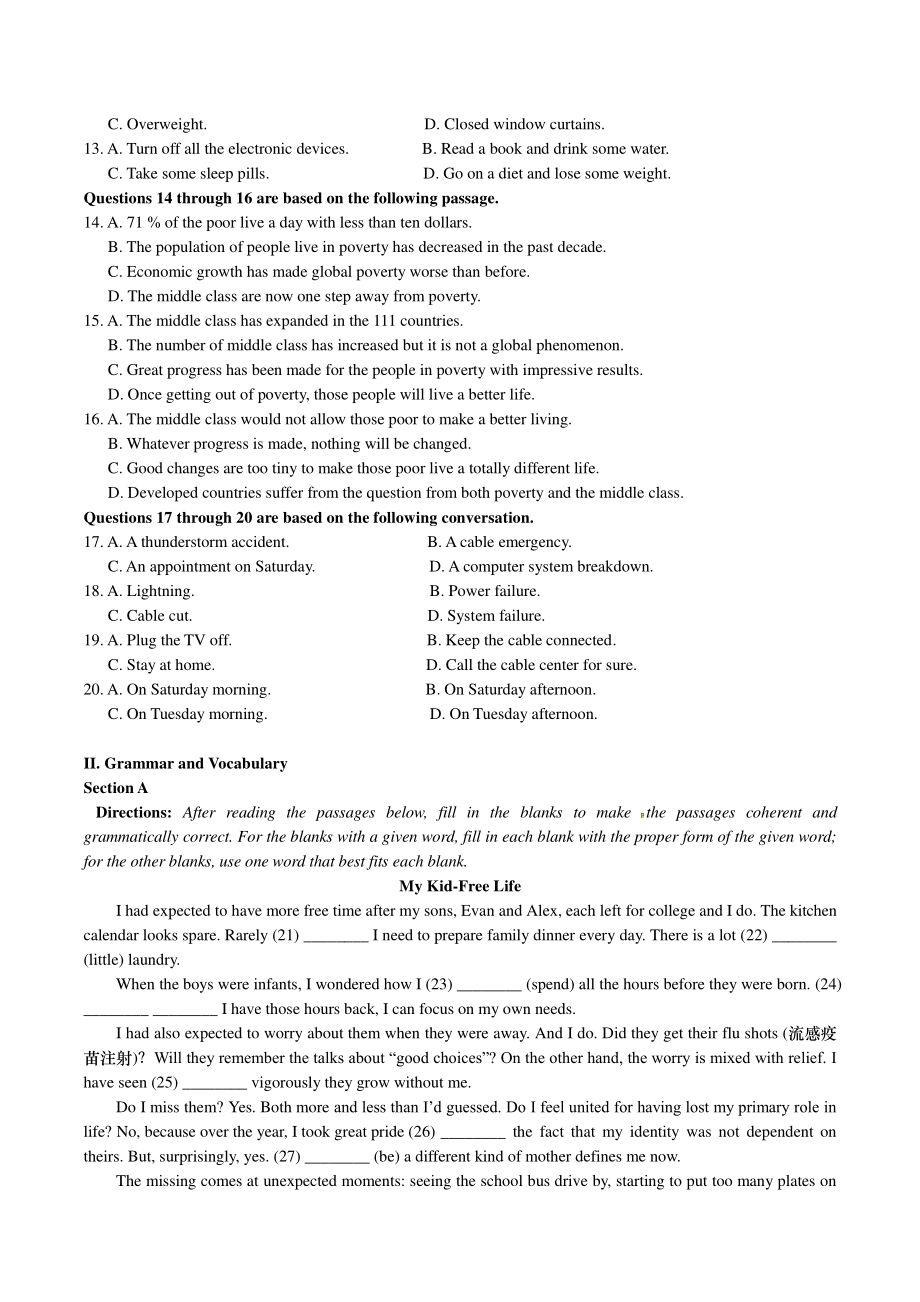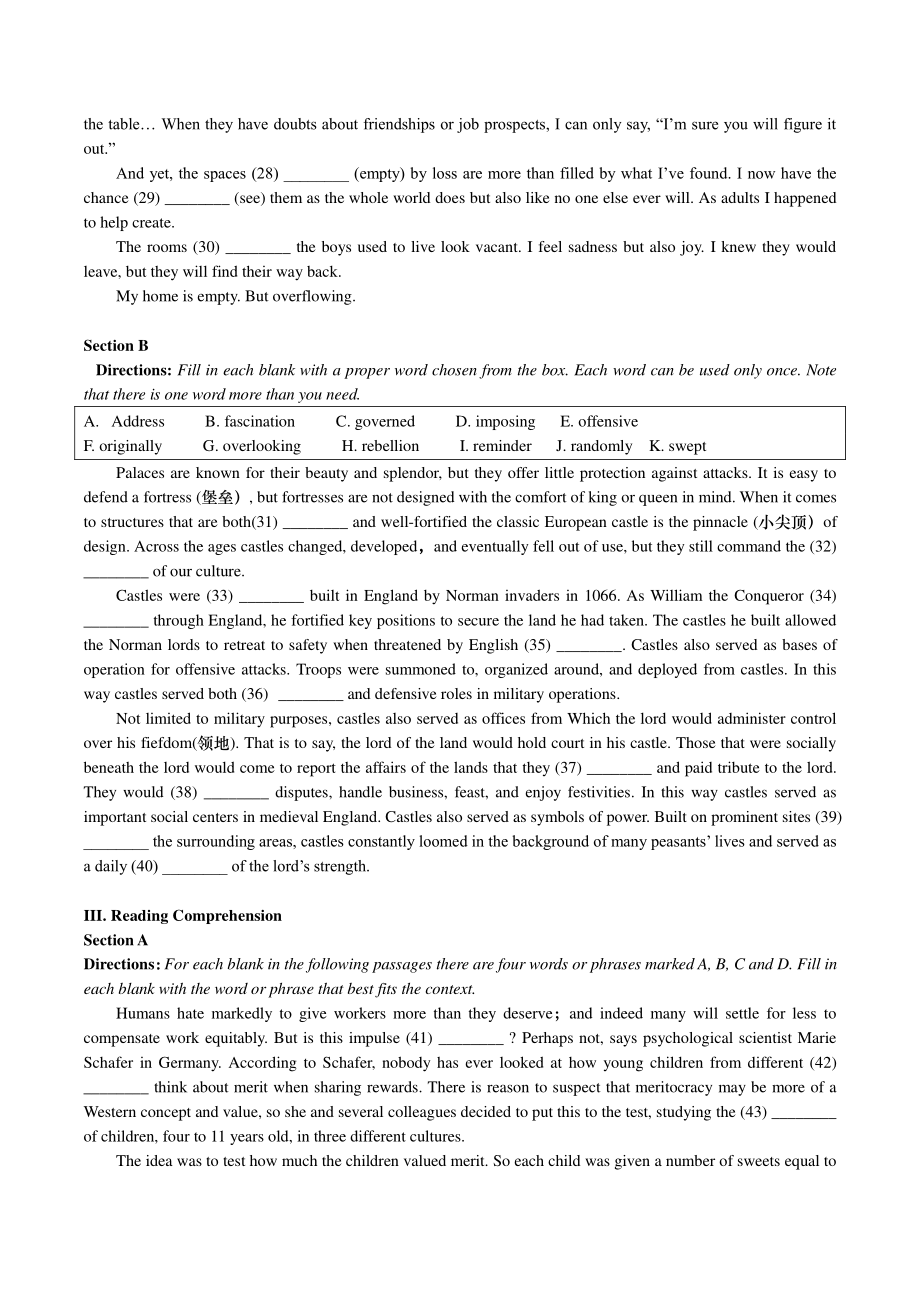 2018年上海市高考春季英语真题试卷(含答案)
2018年上海市高考春季英语真题试卷(含答案)
《2018年上海市高考春季英语真题试卷(含答案)》由会员分享,可在线阅读,更多相关《2018年上海市高考春季英语真题试卷(含答案)(16页珍藏版)》请在七七文库上搜索。
1、 2018 年 1 月上海普通高等招生统一考试 英语试卷 (满分 150 分,考试时间 120 分钟) 考生注意: 答题前,务必在答题纸上填写准考证号和姓名,并将核对后的条形码贴在指定位置上,在答题纸反而清楚地填写姓名。 1. Listening Comprehension Directions: In Section A, you will hear ten short conversations between two speaks. At the end of each conversation, a question will be asked about what was said.
2、 The conversations and the questions will be spoken only once. After you hear a conversation and a question about it, read the four possible answers on your paper, and decide which one is the best answer to the question you have heard. 1. A. Her working all day long. B. The family reunion. C. The an
3、noying housework. D. The intense schedule. 2. A. The kids were frightened by the movie. B. The kids enjoyed the movie. C. The movie is not suitable for kids to see. D. The movie is quite boring. 3. A. She is drinking tea at a table. B. She is interested in reading magazines. C. She likes the picture
4、s in the magazines. D. She doesnt know any Chinese. 4. A. Supermarket. B. Drug store. C. Barber shop. D. Shopping center. 5. A. He likes cooking food himself. B. He thinks frozen food is healthier. C. He accepts the womans invitation. D. He prefers to buy frozen food. 6. A. A full-time student. B. A
5、n exchange student. C. A visiting scholar. D. A part-time student. 7. A. She is bossy. B. She is shy. C. She is arrogant (傲慢的). D. She is trustworthy. 8. A. Hes a teacher. B. Hes a writer. C. Hes a businessman. D. Hes a journalist. 9. A. 1 hour. B. 2 hours. C. 3 hours. D. 4 hours. 10. A. The bad wea
6、ther stopped him. B. His shoes were worn out. C. He didnt like the biking trip. D. Hes too tired to continue. Section B Directions: In Section B, you will hear two short passages and one longer conversation .After each passage or conversation, you will be asked several question. The passages and con
7、versation will be read twice, but the question will be spoken only once. When you hear a question, read the four possible answers on your paper and decide which one is the best answer to the question you have heard. Question 11 through 13 are based on the following passage. 11. A. They became more a
8、ctive in water. B. Symptoms of depression disappeared. C. Their digestion developed. D. They suffered from depression. 12. A. Neon lights. B. Kindle screens. C. Overweight. D. Closed window curtains. 13. A. Turn off all the electronic devices. B. Read a book and drink some water. C. Take some sleep
9、pills. D. Go on a diet and lose some weight. Questions 14 through 16 are based on the following passage. 14. A. 71 % of the poor live a day with less than ten dollars. B. The population of people live in poverty has decreased in the past decade. C. Economic growth has made global poverty worse than
10、before. D. The middle class are now one step away from poverty. 15. A. The middle class has expanded in the 111 countries. B. The number of middle class has increased but it is not a global phenomenon. C. Great progress has been made for the people in poverty with impressive results. D. Once getting
11、 out of poverty, those people will live a better life. 16. A. The middle class would not allow those poor to make a better living. B. Whatever progress is made, nothing will be changed. C. Good changes are too tiny to make those poor live a totally different life. D. Developed countries suffer from
12、the question from both poverty and the middle class. Questions 17 through 20 are based on the following conversation. 17. A. A thunderstorm accident. B. A cable emergency. C. An appointment on Saturday. D. A computer system breakdown. 18. A. Lightning. B. Power failure. C. Cable cut. D. System failu
13、re. 19. A. Plug the TV off. B. Keep the cable connected. C. Stay at home. D. Call the cable center for sure. 20. A. On Saturday morning. B. On Saturday afternoon. C. On Tuesday morning. D. On Tuesday afternoon. II. Grammar and Vocabulary Section A Directions: After reading the passages below, fill i
14、n the blanks to make the passages coherent and grammatically correct. For the blanks with a given word, fill in each blank with the proper form of the given word; for the other blanks, use one word that best fits each blank. My Kid-Free Life I had expected to have more free time after my sons, Evan
15、and Alex, each left for college and I do. The kitchen calendar looks spare. Rarely (21) _ I need to prepare family dinner every day. There is a lot (22) _ (little) laundry. When the boys were infants, I wondered how I (23) _ (spend) all the hours before they were born. (24) _ _ I have those hours ba
16、ck, I can focus on my own needs. I had also expected to worry about them when they were away. And I do. Did they get their flu shots (流感疫苗注射)?Will they remember the talks about “good choices”? On the other hand, the worry is mixed with relief. I have seen (25) _ vigorously they grow without me. Do I
17、 miss them? Yes. Both more and less than Id guessed. Do I feel united for having lost my primary role in life? No, because over the year, I took great pride (26) _ the fact that my identity was not dependent on theirs. But, surprisingly, yes. (27) _ (be) a different kind of mother defines me now. Th
18、e missing comes at unexpected moments: seeing the school bus drive by, starting to put too many plates on the table When they have doubts about friendships or job prospects, I can only say, “Im sure you will figure it out.” And yet, the spaces (28) _ (empty) by loss are more than filled by what Ive
19、found. I now have the chance (29) _ (see) them as the whole world does but also like no one else ever will. As adults I happened to help create. The rooms (30) _ the boys used to live look vacant. I feel sadness but also joy. I knew they would leave, but they will find their way back. My home is emp
20、ty. But overflowing. Section B Directions: Fill in each blank with a proper word chosen from the box. Each word can be used only once. Note that there is one word more than you need. A. Address B. fascination C. governed D. imposing E. offensive F. originally G. overlooking H. rebellion I. reminder
21、J. randomly K. swept Palaces are known for their beauty and splendor, but they offer little protection against attacks. It is easy to defend a fortress (堡垒), but fortresses are not designed with the comfort of king or queen in mind. When it comes to structures that are both(31) _ and well-fortified
22、the classic European castle is the pinnacle (小尖顶)of design. Across the ages castles changed, developed,and eventually fell out of use, but they still command the (32) _ of our culture. Castles were (33) _ built in England by Norman invaders in 1066. As William the Conqueror (34) _ through England, h
23、e fortified key positions to secure the land he had taken. The castles he built allowed the Norman lords to retreat to safety when threatened by English (35) _. Castles also served as bases of operation for offensive attacks. Troops were summoned to, organized around, and deployed from castles. In t
24、his way castles served both (36) _ and defensive roles in military operations. Not limited to military purposes, castles also served as offices from Which the lord would administer control over his fiefdom(领地). That is to say, the lord of the land would hold court in his castle. Those that were soci
25、ally beneath the lord would come to report the affairs of the lands that they (37) _ and paid tribute to the lord. They would (38) _ disputes, handle business, feast, and enjoy festivities. In this way castles served as important social centers in medieval England. Castles also served as symbols of



- 配套讲稿:
如PPT文件的首页显示word图标,表示该PPT已包含配套word讲稿。双击word图标可打开word文档。
- 特殊限制:
部分文档作品中含有的国旗、国徽等图片,仅作为作品整体效果示例展示,禁止商用。设计者仅对作品中独创性部分享有著作权。
- 关 键 词:
- 2018 上海市 高考 春季 英语 试卷 答案
 七七文库所有资源均是用户自行上传分享,仅供网友学习交流,未经上传用户书面授权,请勿作他用。
七七文库所有资源均是用户自行上传分享,仅供网友学习交流,未经上传用户书面授权,请勿作他用。



 浙公网安备33030202001339号
浙公网安备33030202001339号
链接地址:https://www.77wenku.com/p-205222.html